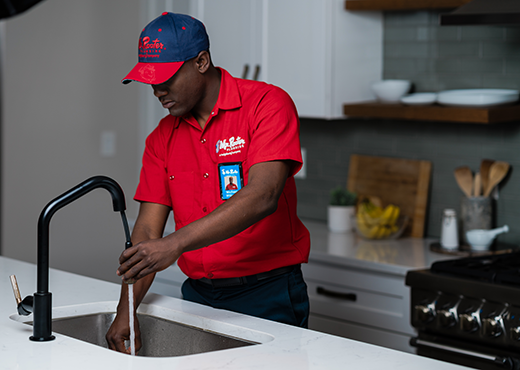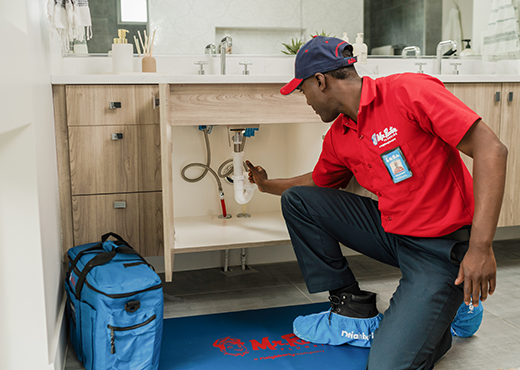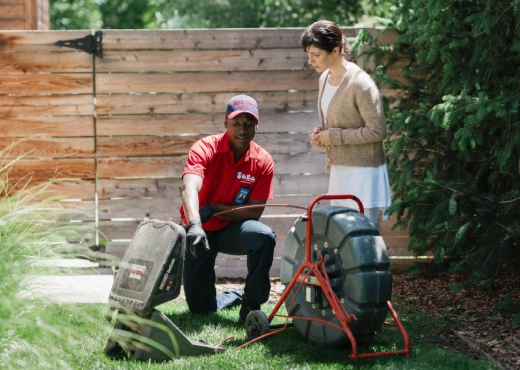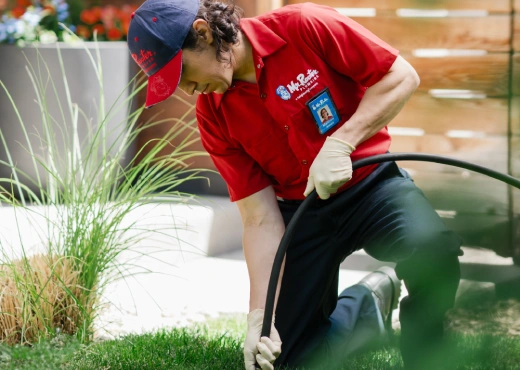It can be difficult to distinguish between the two at first glance because they have a few things in common—you install both in the basement floor and dig up a sump basin for the device to sit in. However, there is an important distinction to be made between these two types of equipment.
A sump pump’s purpose is to divert water from problems like heavy rainfall that could enter your home through basement drains. It has a valve sensor that detects rising water levels and pumps out excess water once it reaches a specified water level. Sump pumps are best suited for homes that are in areas below the water table (the border between water-saturated and unsaturated ground) and those that need extra basement flooding protection because of factors like a combined sewer system.
Rather than water, a sewage ejector pump removes human waste. It’s typically installed in habitable lower levels like basements that sit below main waste lines and directly connects to your sewer or septic line via a discharge pipe. Basement drainage lines that sit below a sewer main or septic system need help to correctly send waste into those systems, as they can’t rely on gravity. A sewage ejector pump uses horsepower to force the waste upward to reach the sewer or septic tank. Depending on where you live and the location of your sewage or septic systems, a sewage ejector pump could be a requirement to help discharge wastewater.
Sump pumps require more cleaning maintenance, whereas sewage ejector pumps require periodic inspections to ensure that no debris is obstructing the float. Paying attention to the lid will also protect you from sewer gas smells and other potential problems. When either of these devices malfunctions, you could experience water or raw sewage flooding.
Common Types of Sewage Ejector Pumps in Ottawa, ON
When deciding on the type you want for replacement or installation, you should look for the specific qualities that will live up to your needs. These devices come in different sizes and weights, which means that if you already have a sump basin ready for installation, the one you choose will need to fit that existing basin.
Key details to consider include:
Technical characteristics
- Horsepower
- Gallons per hour (GPH)
Material
- Cast-iron
- Aluminum
- Thermoplastic
Keep in mind that an Ottawa sewage ejector pump will spend its time submerged in liquid waste and needs to be durable. While thermoplastic is cost-effective, heavy-duty cast iron delivers durability and better performance. Any pump that is able to treat about 128 gallons per minute is considered good. But it depends on your sewer line’s height—the higher it is, the more horsepower you require for your basement in Ottawa. Sewage ejector pumps have a basic capacity of managing two-inches of solids. There are more advanced versions in the market that can handle up to six inches; they also have added features, such as grinding blades or non-clog impeller guarantees.
How Do I Know I Need Ottawa Sewage Ejector Pump Repair Services?
Like every kind of plumbing device, your sewage ejector can either malfunction, reach its maximum lifespan or be poorly installed. With that kind of mechanical device, you could get into very unhygienic situations if anything happens, so the best option to deal with repairs is professional plumbing service from a company like Mr. Rooter Plumbing of Ottawa.
We specialize in installation, maintenance and repair services to ensure your systems are running correctly. If you have never conducted sewage ejector pump installation or repair before, we recommend you call your licensed plumber before attempting to work on your sewage ejector pump. Ottawa, ON property owners that rely on expert plumbers have greater peace of mind than those who attempt DIY repairs.
Of course, discoloured water coming out of basement drains is a clear sign that there are likely problems with a broken sewer pipe or connected system that should be investigated, but that’s not the only common warning sign of a potential fault with your sewage ejector pump. If you keep an eye out for the early warning signs, you can get the services you need before you have to deal with dirty basement flood water and catastrophic water damage.
Ejector pump won’t start
If the pit or basin is filling up but the device shows no reaction, it’s likely a faulty float or something blocking it. Contact your local Ottawa plumber right away and refrain from using your plumbing fixtures until this situation has been resolved.
It’s cycling or running continuously
When liquid waste fills the basin, it should automatically activate and start removing it. Once done, it should turn off. But If it’s ejecting when nothing is there, that’s a clear sign you need an inspection and repairs, as it might have a faulty switch or motor. This could also be a sign of an aging device reaching its life expectancy.
It’s making strange noises
Just like noisy pipes, noisy pumps should be cause for concern. While they’re not the quietest devices, they shouldn’t make alarming sounds like screeching or whining. Those sounds are possible indications that it’s struggling to break down waste and send it through the discharge pipe. This problem is likely related to a faulty motor or impeller.
Sewer Odours
If you smell sewage, check if your system is effectively removing wastewater through the drainage system or whether it’s not properly draining. If it appears to be working fine, you should check the cover lid for cracks.
Clogged system
The device should have no obstructions when sending waste up the discharge pipe that connects to the sewer line, but clogs will happen if waste begins to accumulate there instead. If you have this problem, it’s likely that either your device is becoming less effective due to age, or it doesn’t have the required horsepower to reliably support your plumbing system.
Common Causes of Ottawa Sewage Ejector Pump Failures
These devices normally have a lifespan of up to 16 years, as long as you remember to schedule that routine maintenance and only flush human waste, toilet paper and not garbage. Sometimes, technical issues develop that it’s not possible for the average person to investigate, so it’s safest to get your Ottawa plumber involved to determine whether you require a replacement or repair. Some failures are causes by these incidents:
- Faulty float switch: A float switch floats on top of the water and activates the pump as soon as the basin fills up. If that switch shows no sign of activation, it will require immediate attention. As a temporary solution, you can bypass your faulty float switch by using direct power to activate the pump. We don’t recommend you do it on a regular basis as you can over-exhaust your system, which will then permanently fail. Instead, we recommend service to replace the float switch or the device entirely.
- Clogged Discharge Line: When your system is working slower than usual, it’s worth checking the drainage pipe to see whether it’s partially clogged. This would make your device work harder until it burns out. If a clog goes unnoticed, you will also be at risk of having an overflowing basin.







